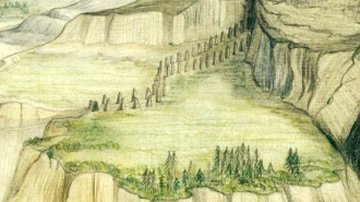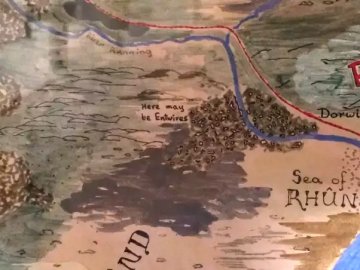
Q: How Many Creatures did J.R.R. Tolkien Invent for Middle-earth?
ANSWER: It’s hard to say how many of the creatures in the various Tolkien books were actual creatures of his own invention. Even Hobbits bear some strong resemblances to certain types of fairy-creatures: they live in hills, they are diminutive in size, they can disappear quickly, they mostly live apart from Men, they have pointed ears, they have mysterious origins, etc.
Nonetheless, I think it is generally agreed that the following creatures were given a very clear profile by Tolkien through his fiction that differentiated them from earlier creatures that may have appeared in mythology, folklore, and fiction.
Giant Eagles – Giant eagles have appeared in various sources, including Norse and Icelandic mythology and also in the writings of Marco Polo. Zeus, one of the prototypes for Manwë, is also associated with giant eagles (including the one that torments Prometheus, who is tied to a rock until Heracles frees him).

Drugs and Drúedain – The Drúgs were a race of humans, perhaps inspired by early (and erroneous) interpretations of the northern human species Neanderthals. The Drúgs were a loyal and good-hearted people who hated evil things, especially Orcs. One branch of Drúgs migrated to Beleriand with the Second House of the Edain, and later settled in Númenor. But after 2,000 years they began leaving the island and returning to Middle-earth, where their descendants survived until the Fourth Age.
Elves – Tolkien’s Elves are, according to him, “biologically human” but they have been given a fate that is separate from the fate of (other) humans (Men and Hobbits). Whereas Men’s spirits “leave the circles of the world” after inhabiting the world for a relatively short span of years, the Elves’ spirits are meant to remain within the circles of the world for as long as the world endures, and hence their bodies sustain those spirits for much longer than the bodies of Men sustain their own spirits. Tolkien’s Elves, unlike many fairy creatures of myth and folklore, seem to be intrinsically drawn toward their mortal cousins in an eery dance of envy: Men long to be “immortal” like the Elves and Elves long to be reassured that there is a future for them (as for Men) after the world ends. Each race wants something the other possesses but they cannot exchange these “gifts”.
Ents – Tolkien’s walking, talking trees seem to be unique, but they are not entirely so. For example, the Greek philosopher/sophist (who lived in the 2nd Century CE) Philostratus told a story about two philosophers (Apollonius and Thespesion) who paused to argue near an Elm tree. When Thespesion commanded the Elm to salute (speak to) Apollonius, it did so “in accents which were articulate and like those of a woman” (Cf. The Life of Apollonius of Tyana by Philastratus). L. Frank Baum also imagined a forest of “fighting trees” who resisted the passage of Dorothy and her companions in The Wizard of Oz. These trees were transformed into the talking apple trees in the 1939 Victor Fleming film adaptation of the story.

Entwives – The female counterparts to the Ents, they never appeared in any of Tolkien’s stories, except in anecdotes recounted by Treebeard for Merry and Pippin. The loss of the Entwives is one of the saddest and most profound events in the history of Middle-earth, and it has inspired fannish debates and artwork for generations.
Huorns – The name literally means “tree hound” but Huorns were a bit more wild and dangerous than your average sheep dog. Huorns might become more like Ents and Ents more like Huorns over time, according to Treebeard, but we’re still not sure how closely related they were.
Hobbits – An offshoot of the Human Race, Hobbits seem to have been made “of sterner stuff” than Men, perhaps even Numenoreans, in many ways. They apparently reached their maturity later than most Men and they retained their vitality until late in life, and they actually seem to have lived slightly longer than Men (except for Numenoreans). Of course, the long-lived Hobbits may only have been notable exceptions.
Orcs – Tolkien himself hinted at the influence on his goblins/orcs from the goblins in George MacDonald’s The Princess and the Goblin but his goblins/orcs also resemble various monsters of legend and folklore. It is generally accepted that Tolkien adapted the word orc from an Old English word, orcnéas (or orcþyrs), for “monster, monster from Hell” — said to be derived from Latin Orcus (although some people question this etymology). Tolkien also admitted in Letter No. 210 that his Orcs are “degraded and repulsive versions of the (to Europeans) least lovely Mongol-types”.
Giant Spiders – There are myths and legends of giant spiders around the world but I cannot identify any that Tolkien might have been aware of. He was widely read and might have heard of some Asian or African legends of giant spiders, but we have no evidence that he was aware of such tales. The only significant spider story from European mythology of which I am aware is the tale of Arachne, a poor Greek maiden whom Athena took pity on. Athena taught Arachne how to be a master-weaver, but Arachne became so arrogant that she refused to honor the gods for her talent. Athena in a final attempt to teach Arachne humility challenged her to a weaving contest. Arachne’s work was perfect, but it was so irreverent (depicting Zeus’ many conquests of mortal women) that Athena grew angry and slew Arachne. But Athena immediately took pity on Arachne and turned her into a spider so that she could continue weaving her beautiful patterns.
Mearas – Magical horses can be found throughout mythologies in Asia, Europe, and Africa. But the Mearas are not quite magical. They’re more intelligent and aware than normal horses and may be descended from Oromë’s Valinorean horses. The Mearas were descended from Felarof, a wild stallion who gave his loyalty to Eorl, first Lord of the Riddermark (Rohan).
Wargs – Demonic wolves can be found in a few mythologies. And it’s safe to say that wolves have been demonized by many cultures around the world. Although an important element in any ecology, wolves don’t mix well with human societyies, especially those engaged in the herding of domesticated animals like sheep. The wargs of The Hobbit could understand human and goblin speech, and appear to have been capable of communication. The wargs the Fellowship of the Ring encountered in Eregion appear to have been magical phantasms, sent either by Saruman or Sauron.
See Also
Answers to Frequently Asked Questions about Tolkien Elves
What Happened to the Entwives?
What Happened to Sauron’s Monsters When He Died?
What Kind of Creature Is Goldberry?
Who Are the Orcs in The Lord of the Rings?
Did J.R.R. Tolkien Invent Orcs?
# # #
Have you read our other Tolkien and Middle-earth Questions and Answers articles?
